Kitesurfing is an exhilarating water sport combining elements of surfing and paragliding. Board size plays a crucial role in performance‚ control‚ and balance‚ ensuring a safe and enjoyable experience.
Overview of Kitesurfing Basics
Kitesurfing combines elements of surfing and paragliding‚ using a kite to propel a rider across water. The setup includes a kite‚ a control bar‚ and a board. Riders attach the kite to a harness and use the control bar to steer. The board‚ similar to a surfboard‚ glides over the water. Basic skills include kite control‚ balance‚ and coordination. As the kite moves‚ it generates power‚ allowing the rider to accelerate. Turning the kite left or right adjusts speed and direction. Proper stance and weight distribution on the board are essential for stability. Beginners often start in shallow water with lighter winds to practice launching and landing the kite. Mastery of these fundamentals is key to advancing in the sport and enjoying its thrilling possibilities.
Why Board Size Matters for Performance
Board size significantly impacts a kitesurfer’s performance‚ affecting speed‚ control‚ and maneuverability. A larger board provides more buoyancy and stability‚ making it easier to stay afloat and ride in lighter winds. However‚ it may feel cumbersome in strong winds or during tricks. A smaller board offers greater agility and faster turns‚ ideal for experienced riders seeking advanced moves. The right size ensures optimal balance‚ allowing riders to harness the kite’s power efficiently. Incorrect sizing can lead to poor control or difficulty staying upright‚ hindering progress. Thus‚ choosing the right board size is crucial for a seamless and enjoyable kitesurfing experience‚ tailored to the rider’s skill level‚ weight‚ and riding style.
Understanding Factors Influencing Board Size
Weight‚ skill level‚ wind conditions‚ and riding style are key factors influencing board size in kitesurfing‚ ensuring optimal performance and safety for riders of all levels.
Rider Weight and Its Impact on Board Size
Rider weight significantly influences board size in kitesurfing. Heavier riders typically require larger boards for buoyancy and stability‚ while lighter riders can maneuver smaller boards more easily. Proper board size ensures efficient water displacement‚ enabling smooth takeoffs and control during turns. Boards designed for heavier riders often feature more volume to maintain floatation‚ whereas lighter riders benefit from boards with less volume‚ enhancing agility. Balancing weight and board size is crucial for optimal performance‚ safety‚ and enjoyment in kitesurfing. Always consult size charts or seek expert advice to determine the ideal board for your weight and riding style.
Skill Level and Board Size Recommendations
Skill Level and Board Size Recommendations
Skill level greatly impacts board size selection in kitesurfing. Beginners often benefit from larger boards with more buoyancy‚ making it easier to stay afloat and balance. These boards provide stability‚ crucial for learning basic maneuvers. Intermediate riders can transition to medium-sized boards‚ offering a balance between stability and maneuverability. Advanced riders prefer smaller boards for greater agility and performance‚ allowing for intricate tricks and tighter turns. The right board size for your skill level enhances learning‚ control‚ and overall performance‚ ensuring a safer and more enjoyable experience on the water. Always consider your skill level when selecting a board to maximize progress and enjoyment in kitesurfing.
Wind Conditions and Their Effect on Board Choice
Wind conditions significantly influence the choice of board size in kitesurfing. In stronger winds‚ smaller boards are preferable as they offer better control and maneuverability‚ reducing the risk of being overwhelmed by powerful gusts. Conversely‚ lighter winds may require larger boards to generate sufficient lift and maintain momentum. The type of wind‚ whether steady or gusty‚ also plays a role; gusty conditions may favor smaller boards for stability‚ while steady winds allow larger boards to perform consistently. Additionally‚ the interaction between board size and kite size must be considered‚ as smaller kites in strong winds pair well with smaller boards‚ and larger kites in light winds complement larger boards. Ultimately‚ wind conditions are crucial for optimizing control‚ stability‚ and overall kitesurfing performance.
Riding Style and Board Size Compatibility

Riding style significantly impacts the choice of board size in kitesurfing. Freestyle riders‚ who prioritize tricks and agility‚ often opt for smaller boards that allow quick turns and precise control. In contrast‚ wave riders benefit from slightly longer boards‚ which enhance stability and smooth transitions on waves. Cruising or recreational riders may prefer medium-sized boards for a balance of stability and maneuverability. Race-oriented riders typically choose larger boards to maximize speed and efficiency. The board’s size must align with the rider’s style to ensure optimal performance and enjoyment. Compatibility between board size and riding style ensures better control‚ ease of handling‚ and the ability to execute maneuvers effectively‚ making it a key consideration for every kitesurfer.
How to Choose the Right Board Size
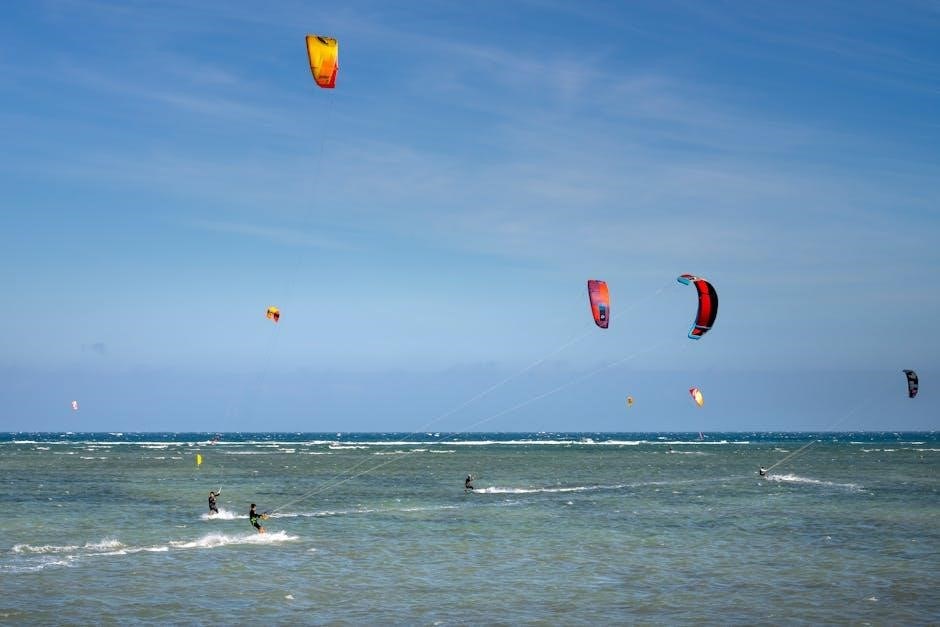
Selecting the ideal board size involves considering rider weight‚ skill level‚ wind conditions‚ and riding style. Proper fit ensures balance‚ control‚ and optimal performance‚ enhancing your kitesurfing experience.
Understanding Kitesurfing Board Size Charts
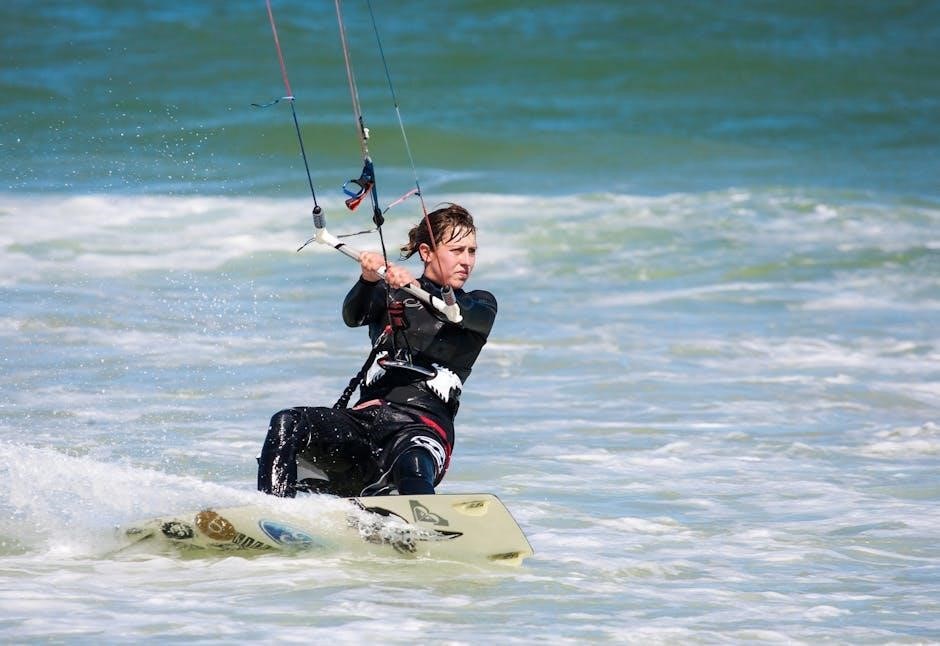
Kitesurfing board size charts are detailed guides that help riders select the appropriate board dimensions based on their weight‚ skill level‚ and riding conditions. These charts typically outline the recommended board length and width for different rider profiles. By considering factors such as wind strength‚ riding style‚ and personal preference‚ the charts provide a starting point for choosing the right board. They often include ranges to accommodate varying conditions‚ ensuring optimal performance and control. Understanding these charts is essential for beginners and experienced riders alike‚ as they help match the board’s capabilities with the rider’s needs. Consulting a size chart can prevent common mistakes‚ such as choosing a board that’s too small or too large‚ and enhance the overall kitesurfing experience.
Step-by-Step Guide to Selecting Your Board
Assess your riding profile‚ including weight‚ skill level‚ and preferred riding style. Lighter riders may prefer smaller boards‚ while heavier riders require larger ones for buoyancy and stability.
Consider wind conditions in your primary riding location. Stronger winds call for smaller boards‚ while lighter winds may require larger boards for better float and momentum.
Consult a board size chart specific to your kiteboarding brand or style‚ as recommendations can vary. These charts often provide a range based on rider weight and wind strength.
Choose a board type that matches your riding style‚ such as freestyle‚ wave‚ or all-around boards. Each type has distinct size recommendations.
Seek advice from experienced riders or instructors to refine your choice based on personal preferences and local conditions.
Test the board if possible‚ as hands-on experience can confirm whether the size feels right for your performance and comfort.
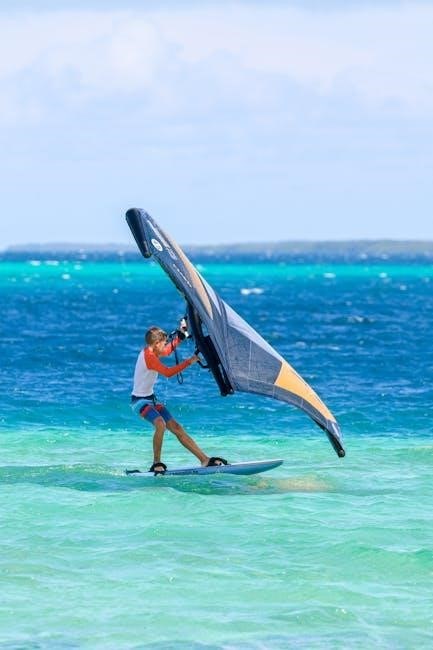
Consequences of Incorrect Board Size
Incorrect board size can lead to poor performance‚ increased fatigue‚ and higher risk of accidents. It affects balance‚ control‚ and overall kitesurfing experience.
Challenges with a Board That’s Too Small
Using a kitesurfing board that’s too small can significantly hinder performance and stability. A smaller board may lack the buoyancy needed to support the rider’s weight‚ especially in choppy waters or for heavier individuals. This can make it difficult to maintain speed and control‚ particularly in stronger winds. Additionally‚ a board that’s too small may not provide enough stability‚ leading to frequent loss of balance and making it harder to stay upright. For beginners‚ a too-small board can complicate the learning process‚ as it requires more effort to maneuver and maintain position. This can increase fatigue and frustration‚ making progress slower. Moreover‚ a smaller board may not handle jumps or tricks as effectively‚ increasing the risk of losing control. Overall‚ a board that’s too small can lead to a less enjoyable and potentially dangerous kitesurfing experience.
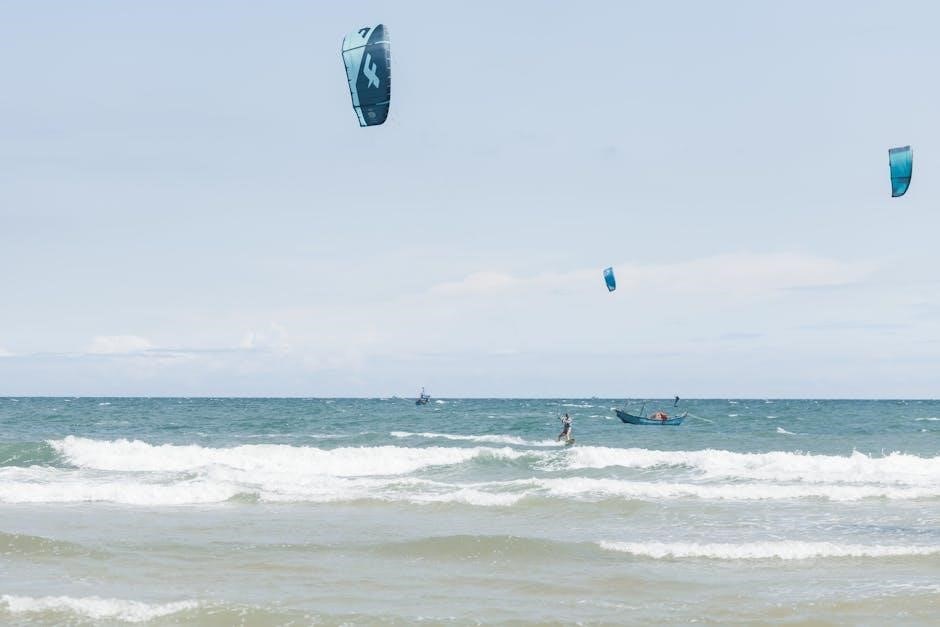
Challenges with a Board That’s Too Large
A board that’s too large can create its own set of challenges for kitesurfers. Oversized boards are often more difficult to maneuver‚ making sharp turns and quick direction changes less responsive. This can be frustrating‚ especially for advanced riders seeking precision and agility. Additionally‚ a larger board may be harder to control in strong winds or choppy conditions‚ as it can become unwieldy and difficult to stabilize. For smaller or lighter riders‚ a board that’s too big may feel cumbersome‚ requiring more strength and effort to manage. Furthermore‚ larger boards can be more challenging to transport and handle on land. While bigger boards may offer more buoyancy‚ they often lack the responsiveness needed for dynamic riding‚ making them less ideal for tricks or high-performance maneuvers. Balancing board size with rider needs is essential for optimal control and enjoyment.
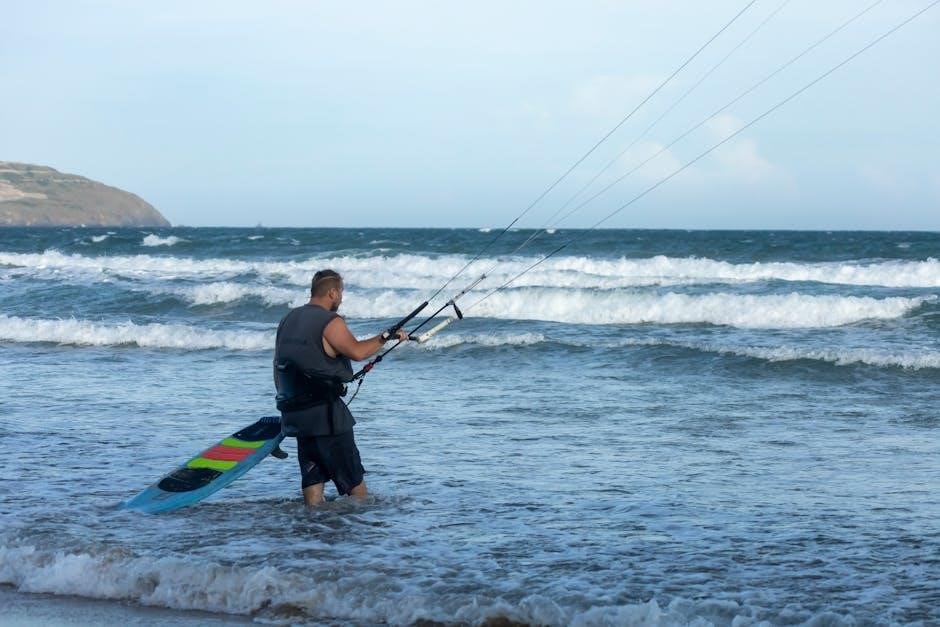
Maintenance and Care for Your Kitesurfing Board
Proper maintenance and care are essential to extend the life of your kitesurfing board and ensure optimal performance. Regularly clean the board to remove dirt‚ sand‚ and salt‚ which can damage the surface over time. Inspect for dings‚ cracks‚ or delaminations‚ and repair them promptly to prevent further damage. Store the board in a cool‚ dry place‚ away from direct sunlight‚ to avoid warping or fading. Avoid exposing the board to extreme temperatures‚ as this can weaken the materials. After each use‚ rinse the board with fresh water and dry it thoroughly to prevent mold or mildew. Use a high-quality board bag for transportation to protect against scratches and impacts. Regular waxing of the board can improve grip and reduce wear. By following these care tips‚ you can maintain your kitesurfing board in excellent condition for years of enjoyable riding.